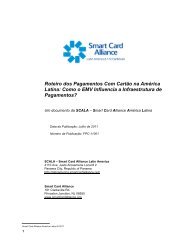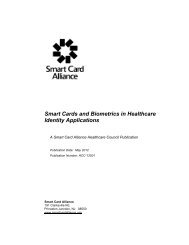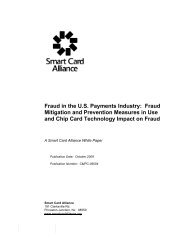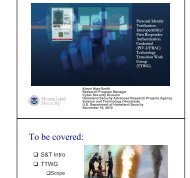2 Foundations for Credential InteroperabilityCreating interoperable identity credentials requires consideration of guidance policies, identityvetting and verification processes, and credentialing technology.2.1 PolicyCurrent state identity and credential policies are typically designed to apply to specific use cases.That is, states issue driver’s licenses to authorize driving, fishing licenses for fishing, and huntinglicenses for hunting; business and medical credentials follow the same approach.However, new policies, technology innovations, and current standards development andprocesses can support a different approach to identity and credentialing. New state policiesrequired by the following national directives can be aligned with strong interoperable identitystandards and <strong>PIV</strong>-I:• Uniform Electronic Transaction Act• Deficit Reduction Act• REAL ID Act and Western Hemisphere Travel Initiative• U.S. Drug Enforcement Agency’s rules for electronically prescribing controlled substances• Draft National Strategy for Trusted Identities in CyberspaceFormulation of a common identity credential approach that addresses these policies can providean opportunity for state executives to enact or ratify standards and deploy resources andinfrastructure to achieve outcomes that are reusable across the state’s identity managementprograms. Resources can be focused on improving outcomes for citizens, businesses,universities, healthcare providers, and governmental entities at all levels.2.1.1 Uniform Electronic Transaction ActThe Uniform Electronic Transaction Act (UETA) was put in final draft form in 1999. 8 A total of 47 stateshave since enacted portions of the UETA into law. The Act facilitates and authorizes the use of electronicrecords and electronic signatures. The legal framework for UETA provides for digital signatures,electronic forms, and other electronic business applications. Several states with PKI programs haveinstituted procedures to convert this policy into practice. The policy in some jurisdictions gives executivesthe authority to approve standards to implement UETA.2.1.2 Deficit Reduction ActIn the Deficit Reduction Act of 2005, the Centers for Medicare and Medicaid Services (CMS) were giventhe mandate to establish the identity, citizenship and entitlement for all beneficiaries and providers.2.1.3 REAL ID Act and Western Hemisphere Travel InitiativeThe REAL ID Act regulates standards for identity proofing that supports trust between citizens, states,and the Federal Government. The Western Hemisphere Travel Initiative (WHTI) 9 requires specificdocuments when entering the United States that will enable the Department of Homeland Security (DHS)to quickly and reliably identify a traveler. States that issue Enhanced Driver Licenses (EDLs) orEnhanced Identification Credentials (EIDs) work together with DHS to set requirements for the issuanceof these documents.Many states are implementing identity programs under these programs using common identity proofingstandards and practices.89http://www.law.upenn.edu/bll/archives/ulc/fnact99/1990s/ueta99.htmhttp://travel.state.gov/travel/cbpmc/cbpmc_2223.html<strong>Smart</strong> <strong>Card</strong> <strong>Alliance</strong> © 20116
2.1.4 U.S. Drug Enforcement Administration’s Rules for ElectronicallyPrescribing Controlled SubstancesOn March 24, 2010, the Drug Enforcement Administration (DEA) published an interim final rule (IFF) inThe Federal Register. In the new regulation, users of e-prescribing systems for controlled substanceswould prove their identities with two of the following three factors: something you know (password);something you have (token); something you are (biometric).The IFF states, “Authentication based only on knowledge factors is easily subverted because they can beobserved, guessed, or hacked and used without the practitioner’s knowledge. In the interim final ruleDEA is allowing the use of a biometric as a substitute for a hard token or a password.” 10As a very high assurance identity credential, <strong>PIV</strong>-I meets and exceeds the authentication requirementsmandated by the DEA.2.1.5 Draft National Strategy for Trusted Identities in CyberspaceThe Draft National Strategy for Trusted Identities in Cyberspace (NSTIC), which is still underdevelopment, provides a policy framework by describing a comprehensive identity ecosystem. Thestrategy includes implementing an interoperable identity for citizens for personal and professional use,including e-mail messages, banking, and access to health information. The strategy can be extended toprotect devices and infrastructure, such as the devices included in and the infrastructure underlying a socalled“smart grid.” The strategy envisions a scenario in which an identity issued in one state can beused to access information locally, regionally, or nationally and can be trusted by public and privateenterprises. An extract from the NSTIC “Executive Summary” clearly identifies the need for acomprehensive strategy for strong identities:One key step in reducing online fraud and identity theft is to increase the level of trust associated withidentities in cyberspace. While this Strategy recognizes the value of anonymity for many onlinetransactions (e.g., blog postings), for other types of transactions (e.g., online banking or accessingelectronic health records) it is important that the parties to that transaction have a high degree of trustthat they are interacting with known entities. Spoofed websites, stolen passwords, and compromisedlogin accounts are all symptoms of an untrustworthy computing environment. This Strategy seeks toidentify ways to raise the level of trust associated with the identities of individuals, organizations,services, and devices involved in certain types of online transactions. 11The NSTIC provides an opportunity for states to leverage <strong>PIV</strong> and <strong>PIV</strong>-I credential definitions and theassociated trust framework to enable enhanced security and privacy, implement strong identity policy andsupport open standards.2.2 ProcessStates have for some time provided credentials that are trusted outside of their domains, in theform of a driver’s license. However, these credentials were never intended to support additionaluse cases such as access to cyberspace, physical resources, or incident scenes.This situation is beginning to change. There are now standards for international electronicdriver’s licenses and identity credentials, and hundreds of millions of credentials have beenissued that meet these standards. In the United States, REAL ID, WHTI and FIPS 201 programsare examples of standards for identity credentialing efforts that are being implemented at thenational and state level. The combination of FIPS 201 with other standards and specifications10 U.S. Dept. of Justice, Drug Enforcement Administration, "Electronic Prescriptions for Controlled Substances," 21CFR Parts 1300, 1304, 1306, 1311, Federal Register notice, Docket No. DEA-2181, RIN 1117-AA61, March 24,2010, page 27.11 "Draft National Strategy for Trusted Identities in Cyberspace," June 25, 2010,http://www.dhs.gov/xlibrary/assets/ns_tic.pdf<strong>Smart</strong> <strong>Card</strong> <strong>Alliance</strong> © 20117
















